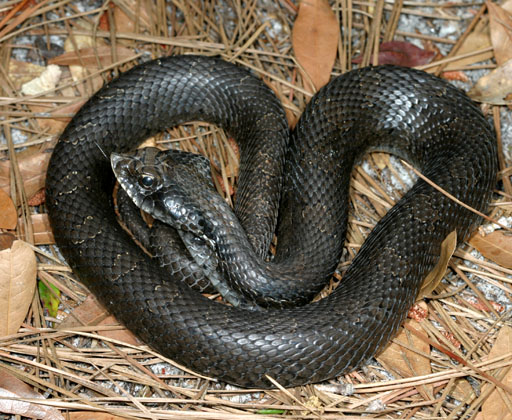Eastern Hog-nosed Snake (Heterodon platirhinos) - Wiki Heterodon platirhinos
From Wikipedia, the free encyclopedia
[Photo] Eastern Hognose Snake, Heterodon platirhinos, dark phase. Location: Holly Shelter Gamelands, Pender County, North Carolina, United States. Source Photograph taken by Patrick Coin. Date 2006-04-23. Author Patrick Coin (http://commons.wikimedia.org/wiki/User:Cotinis)
Common names: eastern hog-nosed snake, spreading adder, hog-nosed snake, more.
Heterodon platirhinos is a snake species found in North America. No subspecies are currently recognized.
Description
Adults average 71 cm (28 inches) in length, with females being larger than males. The most distinguishing feature is the upturned snout, used for digging in sandy soils.
The color pattern is extremely variable. It color can be red, green, orange, brown, grey to black, or any combination therein depending on locality. They can be blotched, checkered, or patternless. The belly tends to be a solid grey, yellow or cream colored.
These snakes are considered rear-fanged, but any venom they excrete is not considered dangerous to humans and they are not inclined to bite.
Common names
Eastern hog-nosed snake, spreading adder, hog-nosed snake, adder, bastard rattlesnake, black adder, black blowing viper, black hog-nosed snake, black viper snake, blauser, blower, blowing adder, blowing snake, blow(ing) viper, blow snake, buckwheat-nose snake, calico snake, checkered adder, checquered adder, chunk head, common hog-nosed snake, common spreading adder, deaf adder, eastern hog-nosed snake, flat-head, flat-head(ed) adder, hay-nose snake, hissing adder, hissing snake, hog-nosed adder, hog-nosed rattler, hog-nose snake, hog-nosed viper, hissing viper, (mountain) moccasin, North American adder, North American hog-nosed snake, pilot, poison viper, puff(ing) adder, red snake, rock adder, rossel bastard, sand adder, sand viper, spotted (spreading) adder, spread-head moccasin, spread-head snake, spread-head viper, (spreading) viper.
Conservation status
This species is classified as Least Concern (LC) on the IUCN Red List of Threatened Species (v3.1, 2001). Species are listed as such due to their wide distribution, presumed large population, or because it is unlikely to be declining fast enough to qualify for listing in a more threatened category. The population trend is stable. Year assessed: 2007.
Behavior
When threatened, the neck is flattened and the head is raised off the ground, not unlike a cobra. They also hiss and sometimes feign strikes, but are not apt to bite. If this threat display does not work to deter a would-be predator, hognose snakes will often roll onto their back and play dead, going so far as to emit a foul musk from their cloaca and let their tongue hang out of their mouth. If they are rolled upright while in this state, they will often roll back as if insisting they are really dead.
Feeding
The eastern hognose snake specializes in feeding on toads, having an immunity to the toxins toads secrete. They will also consume other amphibians, like frogs and salamanders.
Captivity
Eastern hognose snakes are frequently available in the exotic pet trade, but due to their difficult dietary requirements they can be a challenge for some keepers. Evidence has shown that eastern hognose snakes fed a diet which includes rodents tend to develop liver problems, and may have a reduced lifespan. In Canada, eastern hognose snakes are considered to be a species-at-risk (COSEWIC designation: Threatened), and consequently capture or harassment of these animals, including their captive trade, is illegal.
http://en.wikipedia.org/wiki/Heterodon_platirhinos
| The text in this page is based on the copyrighted Wikipedia article shown in above URL. It is used under the GNU Free Documentation License. You may redistribute it, verbatim or modified, providing that you comply with the terms of the GFDL. |
